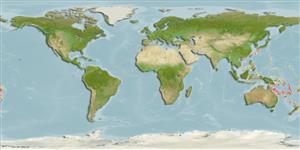>
Anguilliformes (Eels and morays) >
Chlopsidae (False morays)
Etymology: Chlopsis: Greek, chloea = green + Greek, opsis = appearance (Ref. 45335); slusserorum: Named in honor of Marion and Willis Slusser, for their keen interest in natural history and generous support of research and education (Ref. 47953).
Eponymy: Marion Bridgman Slusser (1914–2013) and Willis ‘Bill’ Stanfield Slusser (1915–2010) were enthusiastic amateur naturalists, keen birdwatchers and botanists. [...] (Ref. 128868), visit book page.
More on authors: Tighe & McCosker.
Environment: milieu / climate zone / depth range / distribution range
Ekologi
laut batidemersal; kisaran kedalaman 366 - 487 m (Ref. 47953). Deep-water
Western Central Pacific: Fiji and the Solomon Islands.
Size / Weight / umur
Maturity: Lm ? range ? - ? cm
Max length : 14.1 cm TL jantan/; (Ref. 47953)
deskripsi pendek
Kunci identifiaksi (pengenalan) | Morfologi | Morfometrik
vertebrata, bertulang belakang: 138. Differentiated by its high vertebral count combined with its distinctive pigmentation - light tan, dorso-lateral surface of body overlaid with a series of circa 30-35 dark brown blotches; blotches either do not extend to the dorsal surface (anterior to dorsal origin or near tail) or only weakly extend to the dorsal fin base, which is lightly pigmented for most of its length; blotches do not line up in pairs with blotches on other side of body (Ref. 47953).
Life cycle and mating behavior
Kematangan | Reproduksi, perkembang biakan | Pemijahan | telur-telur | Fecundity | Larva
Tighe, K.A. and J.E. McCosker, 2003. Two new species of the genus Chlopsis (Teleostei: Anguilliformes: Chlopsidae) from the southwestern Pacific. Zootaxa 236:1-8. (Ref. 47953)
Status IUCN Red List (Ref. 130435: Version 2024-2)
ancaman kepada manusia
Harmless
penggunaan manusia
Alat, peralatan
laporan khas
muat turun XML
Sumber internet
Estimates based on models
Preferred temperature (Ref.
123201): 7 - 14.2, mean 11.7 °C (based on 20 cells).
Phylogenetic diversity index (Ref.
82804): PD
50 = 0.5002 [Uniqueness, from 0.5 = low to 2.0 = high].
Bayesian length-weight: a=0.00102 (0.00046 - 0.00225), b=3.06 (2.88 - 3.24), in cm total length, based on all LWR estimates for this body shape (Ref.
93245).
Trophic level (Ref.
69278): 3.7 ±0.6 se; based on size and trophs of closest relatives
Fishing Vulnerability (Ref.
59153): Low vulnerability (10 of 100).
